The Evencut Lawn Mower
Thank you for welcoming me to your site. This is my first post and I'm in eastern Canada.
I was wondering if any of you might be familiar with the "Evencut Lawn Mower" name? I acquired this vintage manual push reel mower recently and I'm in the process of restoring it. I have searched the net, but have not yet found any reference to the name, so I'm not sure if it was a small manufacturer of its own, or if the name was a model manufactured by a larger company. I am presuming, only because of geography, that it was likely made in either Canada or the USA.
You folks likely have more insight into when certain components of these machines changed in materials, for example, wooden-to-rubber rollers, wrought iron-only wheels to ones being sold with tires, and when wooden handles were replaced by metal. Knowing this information would certainly help in narrowing down the date of manufacture, or at least to a range of dates. The earliest I've found rubber tires being made available is from a 1936 advertisement, but I've been advised that in the UK, the Follows & Bates "Climax" model from c. 1870 came with a type of rubber tire.
My Evencut mower came with a two-piece wooden handle, a wooden roller and 8-in. iron-only wheels (no tires). The four cutting blades are 13.5 inches long, the cutting bar is 14 inches long and the machine weighs about 28 lbs. I believe the original colours were gold (wheels and blades), red (the two support bars to the base of the handle) and the brand name letters were painted green.
As for markings, there are "ECL 47" and "ECR 47" (likely EvenCut Left and EvenCut Right) on the left and right insides of their respective sides of the frame, and the "47" may or may not refer to the year of manufacture. I've been advised, by someone with a more knowledge than me, that it may also be a part number or a casting number. In addition, there's "MA5" (see pic, highlighted with chalk for clarity) and a "5" with a symbol similar to the letter "M" beside it, located on the center support disk for the cutter axle. As well, the right pinion gear has "R E B" and the left pinion gear has "L E O" on them. I don't know what the E,O and B signify.
I've been told that it is more likely to have been manufactured closer to the 1910's-1920's. I welcome any insight you may have. Thanks.
- Dave
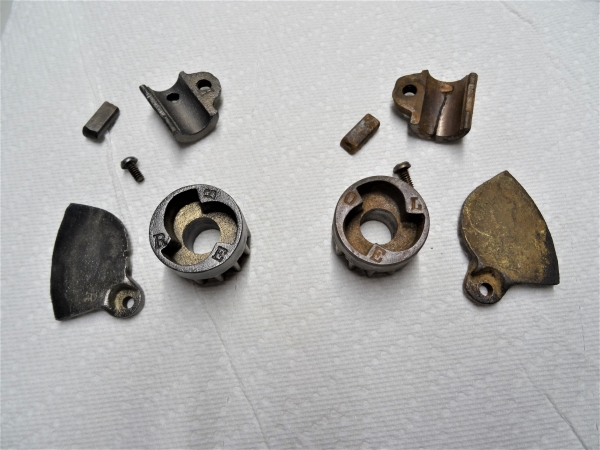
Forums
Hello Dave
Hello Dave
Welcome to the forum & thanks for a challenge to pass a bit of time as I am now in lock down as we have the virus & not allowed to leave our property for a couple of weeks.
Heres what I can tell you so far….
Your mower was made by Taylor Forbes of Geulph, Ontario, Canada who appear to have been producing mowers in Canada from 1874.
The ‘Evencut’ model was certainly being sold in 1939 and into the 1950’s, I have copy advertisements which I will add below. Interesting that there only appears to be one size of 14in (cutting width) and emphasis that the mower had 4 blades.
I am assuming yours is 14in?
I have a Taylor Forbes copy catalogue from the 1890’s for their ‘Woodyatt’ model which is very similar design and could well be the for-runner of the Evencut.
To cover the other points you mention, the rubber tyre on the smaller versions of the Follows & Bate Climax (1870’s) were only on the single drive wheel just to add a bit more friction/grip & perhaps are not considered to be the same as the tyres fitted on later mowers.
In the USA tyres on both wheels did appear I believe in the 1920’s/1930’s, but only on certain models, I have a catalogue from 1935 where tyres were being sold as an extra/addition for old & new mowers, the advertisement is quite amusing so I have added a copy below out of interest, as you wouldn’t want to mar your monuments!!!!!
In the UK I think we were a bit slower to offer rubber tyres, but certainly by the early 1950’s they were being seen on the popular Qualcast mowers, although models without were still available.
As to wooden handles, whilst they were used on some early roller mowers, they were more prevalent when the ‘Side Wheel’ or ‘Reel Mower’ came on the scene, the first being the Philadelphia in 1869 produced by Graham, Emlen & Passmore, this being the first patented mower of this type in the world. Whilst Follows & Bates Climax was patented just afterwards it did retain the metal side handles of the earlier roller mowers.
I hope this helps & will be the first of many mowers you acquire, a quick look & we only seem to have one existing member of the club in Canada, so plenty of room!
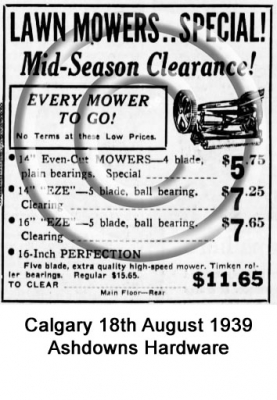
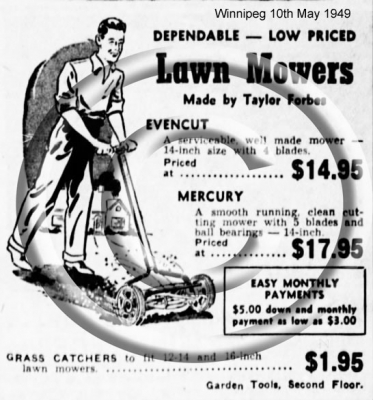
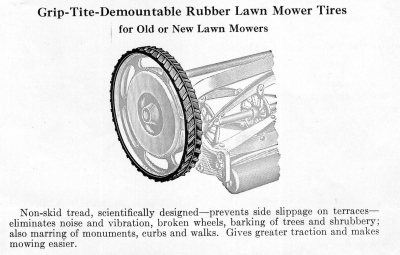
That's great information,
That's great information, Clive! Thank you.
I've found the 4-page leaflet about the Woodyatt lawn mower online and it is indeed very similar to the Evencut. In that leaflet, it says the year of manufacture is indicated by letters on the side plates, so if they followed the same practice when the Evencut was produced, it suggests mine may well have been made in 1947. As well, the copies of the ads you included above, it appears that at some point between 1939-49, they dropped the hyphen in the name; mine does not have the hyphen, further suggesting it was made closer to 1949.
Yes agree with the dating,
Yes agree with the dating, that's a real bonus having the date stamped in the casting, very few other manufacturers did this & always difficult to get a definite fix on the year of manufacture.That small leaflet is excellent.
I have sent a email to you, perhaps check spam if not received.
Hi Dave
Hi Dave
Welcome to the site,Clive has served you well,just a few more tips,casting numbers are not easy to go by,Have a look on the sole pate,that's the casting that your bottom blade is attached to,sometimes the date is cast in,In the USA it was made law to date the machines from the 1880's but not on their export models.The 14 inch is interesting, in the USA the popular size model is 16 inch .
Mowers made in Guiph were actually exported to the UK from the 1920's by a consortium called Cuma Canadian United Manufacturers Association.
My suggestion is to remember that Canada is Commonwealth,so there will be a leaning towards the UK for business,also did you know that Qualcast had a site in Canada!
The subject of tyres,needs to be looked at closely as USA and Canada had a different format of rubber tyre to us in the UK, on your side of the pond, the rubber tyres could be purchased as an extra and pushed tightly on to the cast treads as can be seen with Pennsylvania, here the tyres were moulded into the rim.
Follow and Bates did not use rubber but Gutta Percha which hardens with age.
Unlike allot of collectors in the OLC,we have in the Trust actually been to your side of the pond, found early examples than shipped them home in bulk by the Sea container load! So actually hands on,not just looking at paper!
Clive is right though we are in lock down over here,so difficult to get about other than work,which I still have to go to being in Horticulture working on remote sites, yes Clive they do call that Coventry!
My very best Wishes Andrew
Great information, fellows!
Great information, guys!
On the issue of the early use of tires (perhaps we should have created a separate post just dealing with tires?), I had come across the attached ad from a catalogue put out by Janney, Semple, Hill and Co. (Minneapolis, Minnesota, USA). A check of the company's history (http://www2.mnhs.org/library/findaids/00848.xml) found that the company went by that name between 1866-1875, before it changed its name to Janney, Moles, Brooks and Co. So, it seems the use of "demountable" tires was already underway before the turn of the century.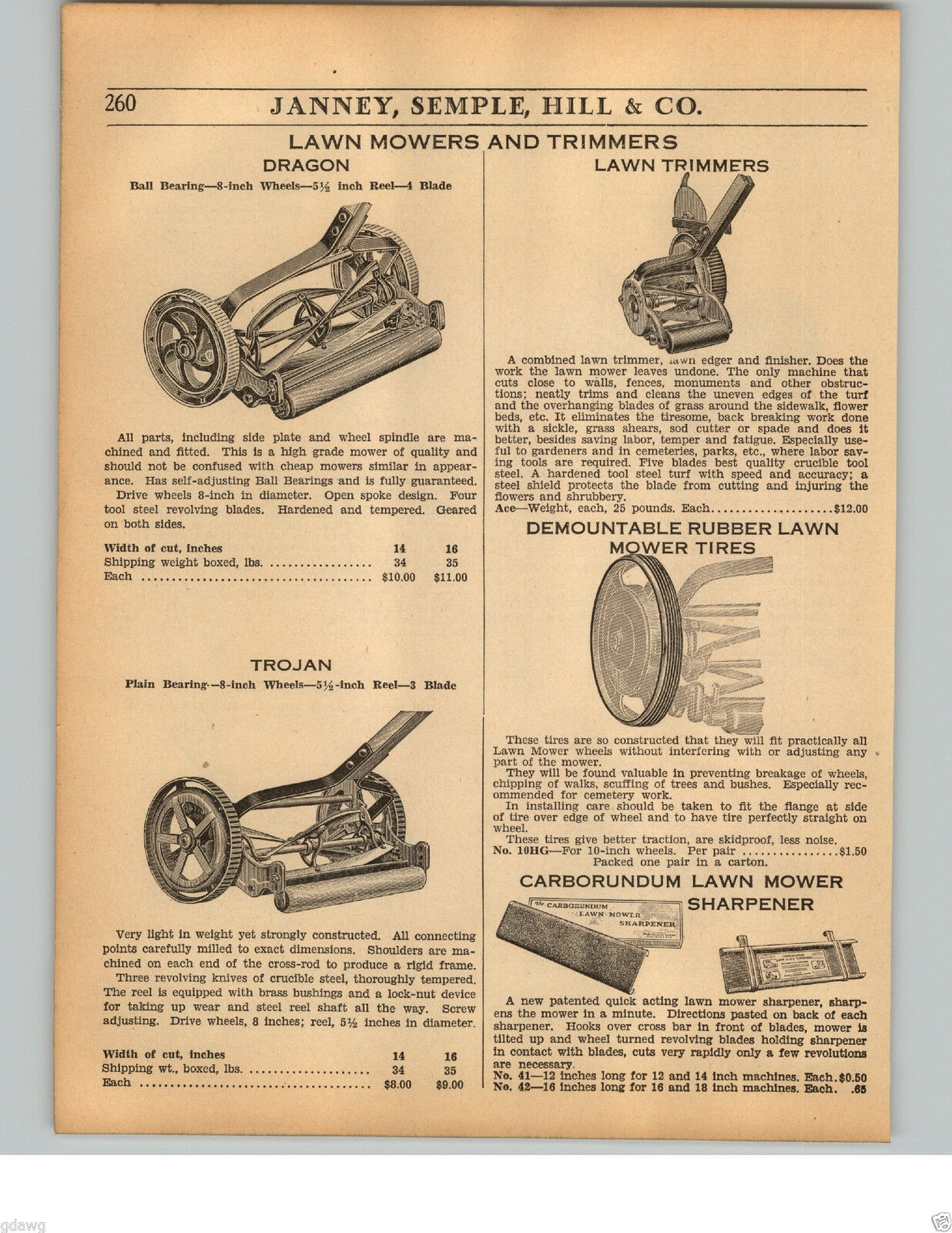
The plot thickens!
The plot thickens!
When researching its always just a word or an items in this case that throws light and sometimes without knowledge. to the individual who placed it.
That newspaper clipping shows a mower called a Trojan,Looking at its castings,and blades,it is the exact machine that was imported to the UK from 1928 up through the 1930's,the only difference was the castings within the wheels which were more ornate (that happened allot with export machines) The sizes it was imported in was 10,12 and 14 inches The export company was as I said before CUMA, Canadian United Manufacturers Association.The main area that CUMA distributed into was Reading (Home counties to London),which also suggests their agents here was Allen & Simmonds, a company here better known for its products of Auto Culto early soil cultivators
Kind regards
Andrew
Anyone know what the letters
Anyone know what the letters on the pinion gears signify (see the 7th pic)? The right pinion gear is stamped with "R E B" and the left pinion gear is stamped with "L E O". The R and L are obvious, but I'm curious about the letters E,O and B.
Hi Dave
Hi Dave
That's easy,they are casting letters and if you ever come across a parts list, that will show up the same.The only problem you will have,is cracking their code,however it runs,
A perfect example is Ransomes over here,all their models start 301
Kind regards
Andrew
Thought I'd update my
Thought I'd update my original post with some pics of the completed restoration of my 14" Evencut Lawn Mower. No doubt there are some purists who would prefer seeing these vintage machines just cleaned up and lubricated, but given that this was my first challenge, I wanted to do more than that.
Except for one nut and bolt, all of the parts are original, and I've restored the original gold colour and green trim lettering. Despite my cleaning and sanding efforts, the wooden handle and especially the wooden roller were too badly stained with decades of grease and grime. So, I decided to stain both with a red mahogany and painted the support brackets green to match the green lettering on the wheels.
It is fully functional, but for now I think I'll keep it as a show piece.
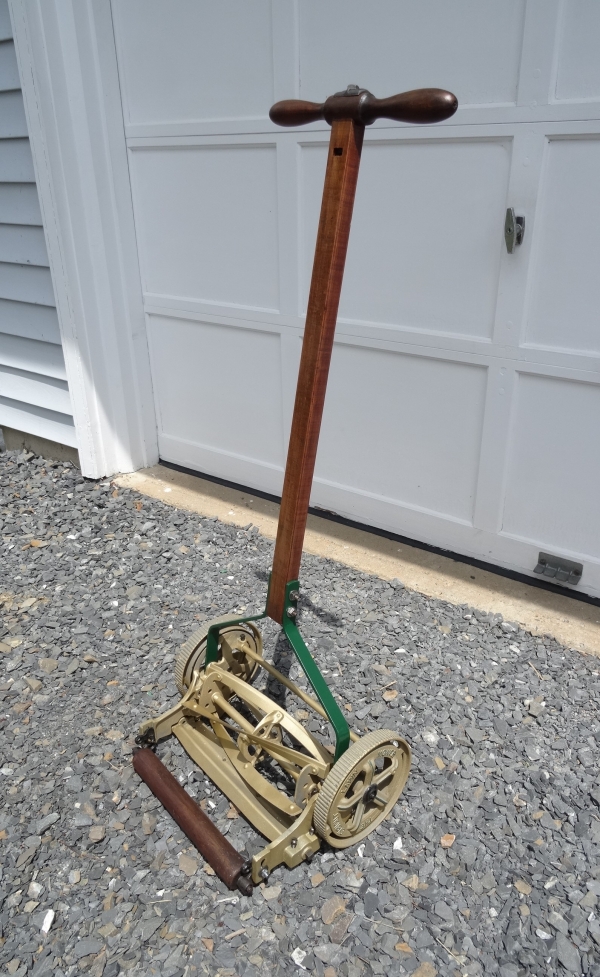
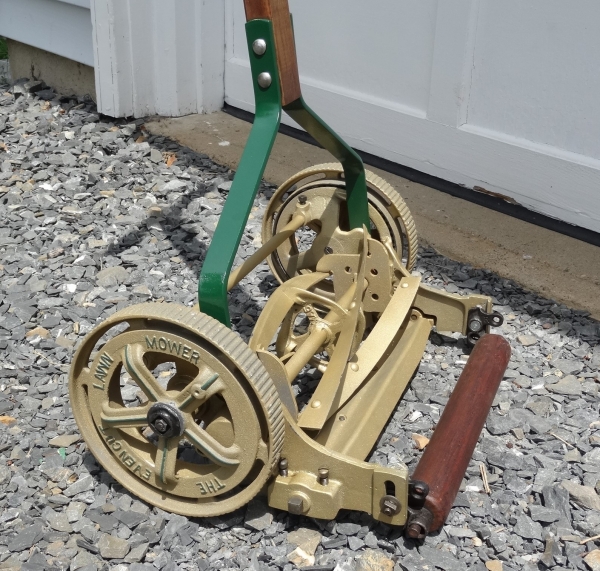
Hello Dave
Hello Dave
A great job & looking good, if used I'm sure it will give a nice even cut, (sorry not one of my best)

Not a brand I'm familiar with
Not a brand I'm familiar with. Suggest looking for evidence of patent numbers on the mower and/or check patent and trademark databases online.